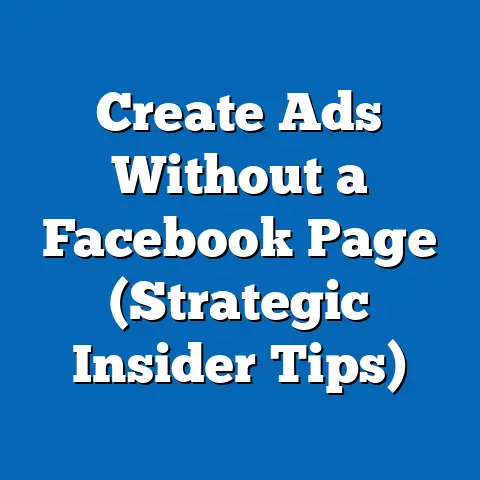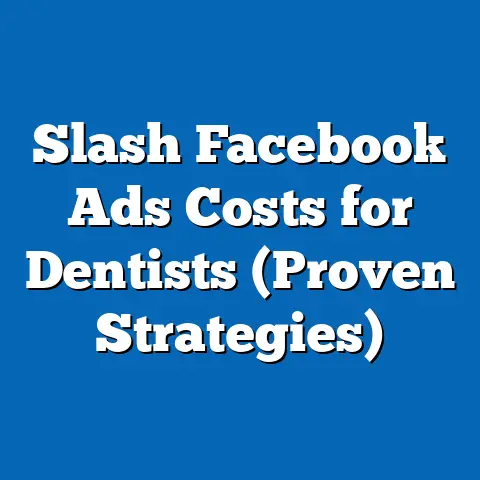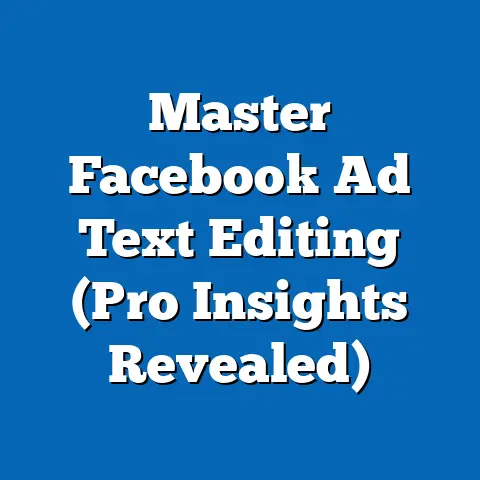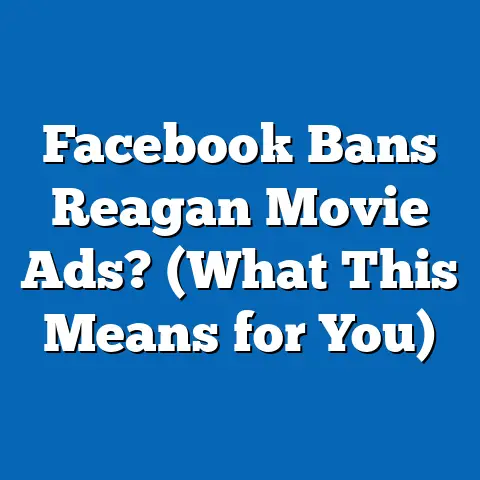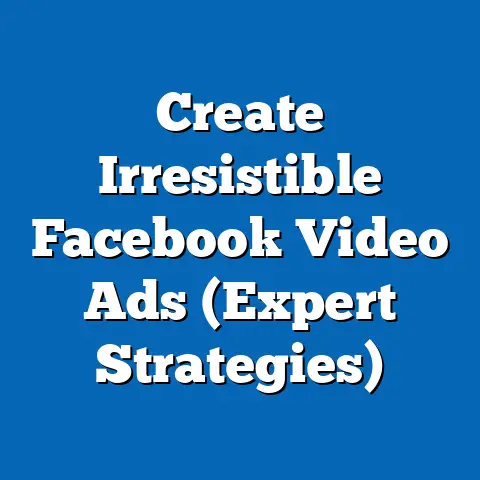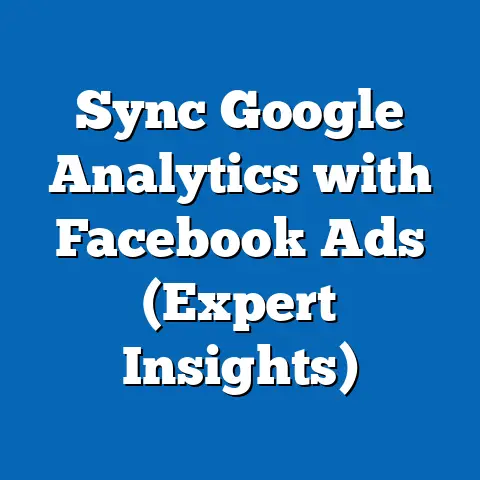Turn Irksome Facebook Ads into Click-Worthy Masters (Pro Tips)
In the dynamic world of digital marketing, capturing and retaining attention is a constant battle. Facebook ads, when done right, can be a powerful weapon in your arsenal. But let’s face it, we’ve all scrolled past countless ads that felt irrelevant, intrusive, or just plain boring. The key to success isn’t just throwing money at the platform; it’s about crafting ads that resonate with your audience, offer value, and ultimately, drive conversions.
Think of creating effective Facebook ads as being a skilled artisan. Just as a master sculptor meticulously chisels away at a block of marble to reveal a stunning masterpiece, we, as marketers, must refine our ad strategies to cut through the noise and captivate our audience. I’ve spent years experimenting with different approaches, analyzing data, and learning from both successes and failures. This article is a culmination of those experiences, a deep dive into the nuances of transforming lackluster Facebook ads into compelling, click-worthy campaigns that not only grab attention but also drive tangible results.
Understanding Your Audience – The Foundation of Craftsmanship
The cornerstone of any successful advertising campaign is a deep understanding of your target audience. You can have the most visually stunning ad with the catchiest copy, but if it’s shown to the wrong people, it’s all for naught. Think of it as trying to sell snow to Eskimos; no matter how persuasive you are, the demand simply isn’t there.
Research and Persona Development
Before even thinking about ad copy or visuals, you need to know who you’re talking to. This is where audience research and persona development come into play.
I always start by asking myself:
- Who are my ideal customers?
- What are their demographics (age, gender, location, income)?
- What are their interests, hobbies, and passions?
- What are their pain points, challenges, and aspirations?
- Where do they spend their time online?
There are several tools and techniques I use to gather these insights:
- Facebook Audience Insights: This is a goldmine of information directly from Facebook. It allows you to explore the demographics, interests, and behaviors of people connected to your Page or custom audiences.
- Surveys: Direct feedback from your existing customers is invaluable. Use tools like SurveyMonkey or Google Forms to create surveys that delve into their motivations, preferences, and experiences.
- Social Listening: Monitor social media platforms for conversations related to your brand, industry, or target audience. This can reveal valuable insights into their needs and concerns. Tools like Mention or Brandwatch can help automate this process.
- Website Analytics: Analyze your website traffic to understand where your visitors are coming from, what pages they’re viewing, and how they’re interacting with your content. Google Analytics is an essential tool for this.
Once you’ve gathered enough data, create detailed buyer personas that represent your ideal customers. Give them names, faces, and backstories. This will help you humanize your audience and make your marketing efforts more targeted and effective.
Takeaway: Invest time in understanding your audience. The more you know about them, the better equipped you’ll be to create ads that resonate and convert.
Psychographics vs. Demographics
While demographics provide a basic understanding of your audience, psychographics delve deeper into their motivations, values, and lifestyle. Understanding the difference is crucial for crafting compelling ad messaging.
- Demographics: Focus on quantifiable characteristics such as age, gender, location, income, education, and occupation.
- Psychographics: Focus on psychological characteristics such as values, interests, attitudes, lifestyle, and personality traits.
Think of it this way: demographics tell you who your audience is, while psychographics tell you why they behave the way they do.
For example, let’s say you’re selling organic skincare products. Targeting based solely on demographics might lead you to target women aged 25-45 with a certain income level. However, a psychographic approach would reveal that your ideal customer is someone who values natural ingredients, cares about environmental sustainability, and is interested in holistic wellness.
By understanding these motivations, you can craft ad messaging that speaks directly to their values and aspirations. Instead of simply highlighting the product’s features, you can focus on the benefits it provides in alignment with their lifestyle.
Example:
- Demographic Targeting: Women, 25-45, Income $50k+, Located in urban areas.
- Psychographic Targeting: Individuals who value natural living, are environmentally conscious, and seek holistic wellness solutions.
- Ad Message: “Nourish your skin and the planet with our organic skincare line. Made with sustainably sourced ingredients and designed for a radiant, healthy glow.”
Takeaway: Combine demographic and psychographic data to create a comprehensive understanding of your audience and craft more effective ad messaging.
The Art of Crafting Compelling Copy
With a solid understanding of your audience in place, it’s time to focus on the art of crafting compelling ad copy. This is where your words need to work their magic, grabbing attention, conveying value, and persuading your audience to take action.
Headline Mastery
Your headline is the first (and sometimes only) thing people will see. It’s your chance to make a lasting impression and entice them to learn more. A weak headline is like a dull knife; it won’t cut through the noise and capture attention.
Here are some tips for crafting headlines that evoke curiosity, urgency, or emotion:
- Ask a Question: Pose a question that addresses a pain point or sparks curiosity.
- Example: “Tired of dull, lifeless skin?”
- Make a Bold Statement: Use a strong statement that challenges the status quo or offers a unique solution.
- Example: “The Secret to Effortless Weight Loss Revealed.”
- Create Urgency: Use words like “Now,” “Limited Time,” or “Don’t Miss Out” to create a sense of urgency.
- Example: “Limited Time Offer: Get 50% Off Your First Order.”
- Use Numbers and Lists: People are naturally drawn to numbers and lists, as they promise clear and concise information.
- Example: “5 Proven Strategies to Boost Your Website Traffic.”
- Highlight a Benefit: Focus on the tangible benefits that your product or service provides.
- Example: “Get More Leads and Sales with Our Powerful Marketing Automation Tool.”
- Example: “Tired of dull, lifeless skin?”
- Example: “The Secret to Effortless Weight Loss Revealed.”
- Example: “Limited Time Offer: Get 50% Off Your First Order.”
- Example: “5 Proven Strategies to Boost Your Website Traffic.”
- Example: “Get More Leads and Sales with Our Powerful Marketing Automation Tool.”
Takeaway: Spend time crafting compelling headlines that grab attention and entice your audience to learn more.
Body Copy that Resonates
Here are some elements of persuasive body copy:
- Storytelling: Use storytelling to connect with your audience on an emotional level. Share a customer testimonial, a personal anecdote, or a compelling narrative that highlights the value of your product or service.
- Value Proposition: Clearly articulate the unique benefits that your product or service provides. What problem does it solve? How will it improve their lives?
- Clear Call to Action (CTA): Tell your audience exactly what you want them to do. Use strong action verbs like “Shop Now,” “Learn More,” “Sign Up,” or “Get Started.” Make your CTA prominent and easy to click.
- Social Proof: Include testimonials, reviews, or case studies to build trust and credibility. People are more likely to take action if they see that others have had positive experiences with your brand.
- Address Objections: Anticipate and address any potential objections that your audience might have. This shows that you understand their concerns and are confident in your ability to provide a solution.
Example:
- Headline: “Tired of Wasting Money on Ineffective Ads?”
- Body Copy: “Our AI-powered advertising platform helps you optimize your campaigns for maximum ROI. We use cutting-edge technology to target the right audience, personalize your messaging, and track your results in real-time. See why thousands of businesses are switching to our platform. Get a free trial today!”
- CTA: “Start Your Free Trial Now”
Takeaway: Craft persuasive body copy that tells a story, highlights your value proposition, and includes a clear call to action.
Utilizing User-Generated Content
User-generated content (UGC) is any form of content – such as images, videos, reviews, or testimonials – that has been created by your customers or fans. It’s a powerful tool for building trust, authenticity, and social proof.
Think about it: people are more likely to trust the recommendations of their peers than they are to trust advertising from a brand. UGC leverages this inherent trust to create more persuasive and engaging ads.
Here are some strategies for incorporating UGC into your Facebook ads:
- Run Contests and Giveaways: Encourage your customers to create content related to your brand by offering incentives such as prizes or discounts.
- Ask for Testimonials and Reviews: Reach out to your satisfied customers and ask them to share their experiences. Feature their testimonials and reviews in your ads.
- Monitor Social Media: Keep an eye on social media platforms for mentions of your brand. Reach out to customers who have shared positive experiences and ask for permission to use their content in your ads.
- Create a Branded Hashtag: Encourage your customers to use a branded hashtag when sharing content related to your brand. This makes it easier to find and curate UGC.
Example:
Visual Aesthetics – Designing Eye-Catching Ads
In the crowded landscape of Facebook, visuals are your secret weapon for grabbing attention. A compelling image or video can stop scrollers in their tracks and entice them to learn more. Think of your ad visuals as the storefront of your business; they need to be inviting, engaging, and representative of your brand.
The Role of Visuals in Ads
Visuals play a crucial role in enhancing ad performance and driving engagement. They can:
- Capture Attention: A visually appealing image or video can immediately grab attention and entice people to stop scrolling.
- Communicate Value: Visuals can quickly communicate the value of your product or service. Show your product in action, highlight its key features, or showcase the benefits it provides.
- Evoke Emotion: Visuals can evoke emotions and connect with your audience on a deeper level. Use images and videos that resonate with their values, aspirations, and pain points.
- Reinforce Messaging: Visuals can reinforce your ad copy and make your message more memorable. Choose images and videos that are aligned with your brand identity and messaging.
Here are some design principles to keep in mind:
- Keep it Simple: Avoid clutter and distractions. Focus on a single, clear message.
- Use High-Quality Images and Videos: Invest in professional photography and videography or use high-quality stock images and videos.
- Choose Colors Wisely: Use colors that are aligned with your brand identity and that evoke the desired emotions.
- Use Typography Effectively: Choose fonts that are easy to read and that complement your brand identity.
- Maintain Consistency: Ensure that your visuals are consistent with your brand identity and messaging.
Takeaway: Invest in high-quality visuals that capture attention, communicate value, and reinforce your messaging.
Choosing the Right Formats
Facebook offers a variety of ad formats to choose from, each with its own strengths and weaknesses. Understanding the different formats and their respective advantages is crucial for creating effective ads.
Here’s a quick overview of some of the most popular ad formats:
- Image Ads: Simple and effective, image ads are a great way to showcase your product or service with a single, visually appealing image.
- Video Ads: Video ads are highly engaging and can be used to tell a story, demonstrate your product, or share a testimonial.
- Carousel Ads: Carousel ads allow you to showcase multiple images or videos in a single ad unit. This is a great way to highlight different features of your product or service.
- Collection Ads: Collection ads are designed for e-commerce businesses and allow you to showcase a catalog of products in a visually appealing format.
- Lead Ads: Lead ads make it easy for people to sign up for your email list or request more information without leaving Facebook.
- Instant Experience Ads: Instant Experience ads are full-screen, mobile-optimized ads that load instantly and provide an immersive experience.
Example:
- Goal: Drive traffic to your website to increase sales.
- Recommended Ad Format: Carousel ad showcasing different products with links to the corresponding product pages on your website.
Takeaway: Choose the ad format that best aligns with your marketing goals and target audience.
A/B Testing Visuals
A/B testing, also known as split testing, is the process of comparing two versions of an ad to see which one performs better. This is a crucial step in optimizing your ad campaigns and ensuring that you’re getting the most bang for your buck.
When it comes to visuals, here are some elements you can A/B test:
- Images: Test different images to see which ones resonate best with your audience.
- Videos: Test different videos to see which ones are most engaging and effective.
- Colors: Test different colors to see which ones capture attention and evoke the desired emotions.
- Typography: Test different fonts to see which ones are easiest to read and most visually appealing.
- Layout: Test different layouts to see which ones are most effective at showcasing your product or service.
Example:
- Version A: Ad with a product image on a white background.
- Version B: Ad with a product image in a real-world setting.
Takeaway: Continuously A/B test your visuals to see which elements resonate best with your audience and improve your ad performance.
The Science of Targeting and Retargeting
Effective targeting is the science behind getting your ads in front of the right people. It’s about identifying your ideal customers and then using Facebook’s targeting options to reach them with precision. Retargeting, on the other hand, is about nurturing leads and re-engaging with people who have already shown interest in your brand.
Precision Targeting
Facebook offers a wide range of targeting options to help you reach your ideal customers. Here are some of the most popular:
- Demographic Targeting: Target based on age, gender, location, education, and occupation.
- Interest Targeting: Target based on interests, hobbies, and passions.
- Behavior Targeting: Target based on online behavior, such as purchase history, website visits, and app usage.
- Custom Audiences: Create custom audiences based on your existing customer data, website traffic, or app activity.
- Lookalike Audiences: Create lookalike audiences based on your custom audiences. This allows you to reach new people who share similar characteristics to your existing customers.
Example:
- Target Audience: Small business owners who are interested in marketing automation.
- Targeting Options:
- Demographics: Age 25-55, Location: United States, Occupation: Business Owner
- Interests: Marketing Automation, Small Business Marketing, Digital Marketing
- Custom Audience: People who have visited your website or signed up for your email list.
- Lookalike Audience: Create a lookalike audience based on your custom audience.
- Demographics: Age 25-55, Location: United States, Occupation: Business Owner
- Interests: Marketing Automation, Small Business Marketing, Digital Marketing
- Custom Audience: People who have visited your website or signed up for your email list.
- Lookalike Audience: Create a lookalike audience based on your custom audience.
Takeaway: Use a combination of targeting options to reach your ideal customers with precision.
Retargeting Strategies
Retargeting is the practice of showing ads to people who have already interacted with your brand in some way, such as visiting your website, signing up for your email list, or watching a video. It’s a highly effective strategy for nurturing leads and driving conversions.
Here are some examples of effective retargeting campaigns:
- Website Retargeting: Show ads to people who have visited your website but haven’t made a purchase. Remind them of the products they viewed and offer a discount to incentivize them to buy.
- Email Retargeting: Show ads to people who are on your email list but haven’t opened your emails in a while. Offer them a special promotion or exclusive content to re-engage them.
- Video Retargeting: Show ads to people who have watched a video on your Facebook page. Offer them a free trial or a discount to take the next step.
Example:
- Target Audience: People who have visited your product page but haven’t added the product to their cart.
- Ad Message: “Still thinking about it? Get 10% off your order when you complete your purchase today!”
Takeaway: Use retargeting to nurture leads and re-engage with people who have already shown interest in your brand.
Leveraging Data and Analytics for Continuous Improvement
Data is your compass in the ever-changing landscape of Facebook advertising. By tracking key metrics, analyzing performance data, and staying ahead of trends, you can continuously improve your campaigns and maximize your ROI.
Key Metrics to Track
There are several key metrics that you should track to measure the performance of your Facebook ads:
- Click-Through Rate (CTR): The percentage of people who see your ad and click on it. A high CTR indicates that your ad is relevant and engaging.
- Cost Per Click (CPC): The amount you pay each time someone clicks on your ad. A low CPC indicates that your ad is efficient.
- Conversion Rate: The percentage of people who click on your ad and complete a desired action, such as making a purchase or signing up for your email list. A high conversion rate indicates that your ad is effective at driving results.
- Return on Ad Spend (ROAS): The amount of revenue you generate for every dollar you spend on advertising. A high ROAS indicates that your ad is profitable.
- Cost Per Acquisition (CPA): The amount you pay to acquire a new customer. A low CPA indicates that your ad is efficient at acquiring new customers.
Takeaway: Track these key metrics to measure the performance of your Facebook ads and identify areas for improvement.
Using Insights to Optimize Campaigns
Analyzing your ad performance data is crucial for identifying strengths and weaknesses and optimizing your campaigns for maximum ROI.
Here are some actionable steps you can take based on your data:
- Low CTR: If your CTR is low, try improving your ad copy, visuals, or targeting.
- High CPC: If your CPC is high, try refining your targeting or experimenting with different ad formats.
- Low Conversion Rate: If your conversion rate is low, try improving your landing page, simplifying the checkout process, or offering a discount.
- Low ROAS: If your ROAS is low, try optimizing your targeting, ad copy, and landing page to drive more conversions.
Example:
- Data: Your CTR is low, but your conversion rate is high.
- Action: Focus on improving your ad copy and visuals to attract more clicks.
Takeaway: Continuously analyze your ad performance data and make data-driven decisions to optimize your campaigns.
Staying Ahead of Trends
The Facebook advertising landscape is constantly evolving. New features, algorithms, and best practices are constantly emerging. To stay ahead of the curve, it’s important to stay informed and adapt your strategies accordingly.
Here are some resources for ongoing learning:
- Facebook Business Help Center: The official resource for all things Facebook advertising.
- Industry Blogs and Publications: Follow reputable blogs and publications that cover Facebook advertising trends and best practices.
- Online Courses and Communities: Enroll in online courses and join online communities to learn from experts and connect with other marketers.
- Experimentation: Continuously experiment with new features and strategies to see what works best for your business.
Takeaway: Stay informed about the latest trends and changes in the Facebook advertising landscape and adapt your strategies accordingly.
Mastering the Craft of Facebook Ads
In conclusion, the art of crafting effective Facebook ads is a blend of creativity, data analysis, and continuous learning. It’s about understanding your audience, honing your copywriting skills, creating visually captivating designs, utilizing precise targeting, and leveraging data to optimize your campaigns.
As digital consumers continue to evolve, so must the craftsmanship behind Facebook ads. Embrace the art and science of Facebook advertising, and watch your campaigns flourish in a competitive landscape. It’s a journey of continuous improvement, but the rewards are well worth the effort. So, go forth and transform those irksome interruptions into click-worthy masterpieces!

